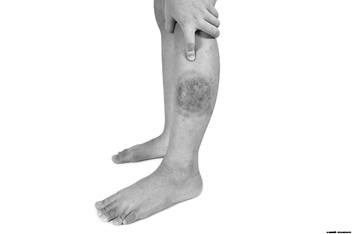Ringworm of the Scalp (Tinea Capitis)

Tinea capitis is also called ringworm of the scalp, but it’s not caused by a worm. It’s a fungus infection. A fungus is a germ that is too small to see.
Ringworm is very contagious (spreads easily) among children. It most often happens in children 4 to 7 years old. However, it can happen in children as young as 1 year of age. It is rare in adults.
How the Infection Spreads
The fungus usually spreads when a child:
- Comes in direct contact with the head or hairs of someone who has ringworm.
- Uses a comb, brush, hat, stuffed toy, towel, or pillowcase of an infected person.
- Comes in contact with an infected animal.
Symptoms

- Ringworm can be on parts of the scalp or all of it. The scalp will have:
- Round, bald patches with black dots where the hair has broken off (Picture 1). Blonde-haired children will have blonde dots.
- Dry raised scales and crusty bumps. These might drain pus and be tender.
- Itchiness.
- Sometimes a child may have lumps (swollen glands) in the neck and back of the head.
- Ringworm usually doesn’t cause fevers.
Diagnosis
Your child’s doctor or health care provider can tell if they have ringworm by the way their scalp looks. Sometimes, they may send a bit of the scaly skin and/or hairs for testing. It usually takes 2 to 3 weeks to get the test results back.
Treatment
Ringworm won’t go away on its own. Medicine and a special antifungal shampoo can cure it. Treatment should start early to prevent scarring or damage to the scalp. It may take many weeks to go away.
- Your child’s doctor or health care provider will prescribe a medicine to be taken by mouth for 1 to 3 months. The medicine goes through the blood to the scalp and into the growing hairs to stop the fungus from growing.
- With some medicines, your child may need to eat fatty foods, such as whole milk, cheese, ice cream, or yogurt to help the medicine work better.

- The infection may come back if your child stops the medicine too early
- Do not use over-the-counter (OTC) creams or ointments. These might work for ringworm on the body or athlete’s foot, but they do not work for ringworm of the scalp
- Your child’s doctor or health care provider will suggest or prescribe a special antifungal shampoo (Picture 2). The shampoo will make it harder for the fungus to spread to others. It is not a cure by itself.
- Do not shave your child’s head.
- All household members, even those not infected, should also use the antifungal shampoo to reduce their risk of infection. They should use it 2 to 3 times a week for about 6 weeks.
Prevention
- No one should share combs, hairbrushes, hats, stuffed toys, towels, or pillowcases with others.
- Soak combs and hairbrushes in a mixture of half bleach and half water for 1 hour each day. Do this for the first 3 days after you start giving the medicine and using the antifungal shampoo.
- Wash towels in warm, soapy water after each use. Rinse and dry.
- Wash your hands after touching pets and animals.
- Some OTC dandruff shampoos (Selsun Blue® or Head and Shoulders®) can help prevent the spread of the fungus. Ask your doctor or health care provider about these.
More Information
- Some children who have ringworm need to stay home from school. Your child’s doctor or health care provider will tell you when they may go back.
- If your child takes the medicine for longer than 6 to 8 weeks or needs to repeat the course of treatment, they may need blood tests to check for side effects of the medicine.
- The places where hair has fallen out will usually grow back after your child finishes their treatment. It may take several months.
When to Call the Doctor
-
Call your child’s doctor or health care provider if:
- The infection is not getting better after 4 weeks of therapy.
- Patches on their scalp drain pus and are painful.
- They have a fever or temperature:
- Of 104° Fahrenheit (F) or 40° Celsius (C) or above.
- Above 102°F (38.9°C) for more than 2 days or it keeps coming back.
These things could mean that your child may also have a bacterial infection.
HH-I-145 • ©1991, revised 2023 • Nationwide Children's Hospital

